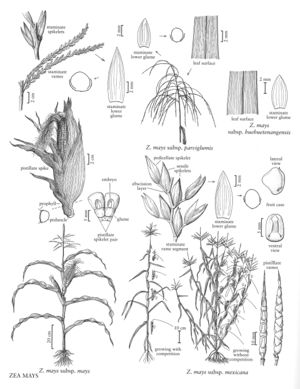Difference between revisions of "Zea mays subsp. mexicana"
FNA>Volume Importer |
GeoffLevin (talk | contribs) (Fixed spelling of "Iltis" throughout) |
||
| (5 intermediate revisions by 2 users not shown) | |||
| Line 1: | Line 1: | ||
{{Treatment/ID | {{Treatment/ID | ||
|accepted_name=Zea mays subsp. mexicana | |accepted_name=Zea mays subsp. mexicana | ||
| − | |accepted_authority=(Schrad.) H.H. | + | |accepted_authority=(Schrad.) H.H. Iltis |
|publications= | |publications= | ||
|common_names=Chalco teosinte;Central-plateau teosinte;Nobogame teosinte | |common_names=Chalco teosinte;Central-plateau teosinte;Nobogame teosinte | ||
| Line 7: | Line 7: | ||
|synonyms={{Treatment/ID/Synonym | |synonyms={{Treatment/ID/Synonym | ||
|name=Zea mexicana | |name=Zea mexicana | ||
| − | |authority= | + | |authority= |
| + | |rank=species | ||
}} | }} | ||
|hierarchy=Poaceae;Poaceae subfam. Panicoideae;Poaceae tribe Andropogoneae;Zea;Zea mays;Zea mays subsp. mexicana | |hierarchy=Poaceae;Poaceae subfam. Panicoideae;Poaceae tribe Andropogoneae;Zea;Zea mays;Zea mays subsp. mexicana | ||
| Line 19: | Line 20: | ||
-->{{Treatment/Body | -->{{Treatment/Body | ||
| − | |discussion=<p>Zea mays subsp. mexicana is a weedy taxon, native to upland Mexico. It is most abundant in the Meseta Central of the Mexican neo-volcanic plateau, at elevations of 1700-2500 m. It grows almost entirely in and around cornfields, and readily hybridizes with subsp. mays. The long-day tolerant 'Northern Teosinte' is the result of a series of backcrosses between such hybrids and the northernmost population of subsp. mexicana, 'Nobogame Teosinte'.</p> | + | |discussion=<p><i>Zea mays </i>subsp.<i> mexicana</i> is a weedy taxon, native to upland Mexico. It is most abundant in the Meseta Central of the Mexican neo-volcanic plateau, at elevations of 1700-2500 m. It grows almost entirely in and around cornfields, and readily hybridizes with <i></i>subsp.<i> mays</i>. The long-day tolerant 'Northern Teosinte' is the result of a series of backcrosses between such hybrids and the northernmost population of <i></i>subsp.<i> mexicana</i>, 'Nobogame Teosinte'.</p> |
|tables= | |tables= | ||
|references= | |references= | ||
| Line 28: | Line 29: | ||
-->{{#Taxon: | -->{{#Taxon: | ||
name=Zea mays subsp. mexicana | name=Zea mays subsp. mexicana | ||
| − | + | |authority=(Schrad.) H.H. Iltis | |
| − | |authority=(Schrad.) H.H. | ||
|rank=subspecies | |rank=subspecies | ||
|parent rank=species | |parent rank=species | ||
| Line 36: | Line 36: | ||
|family=Poaceae | |family=Poaceae | ||
|illustrator=Linda A. Vorobik | |illustrator=Linda A. Vorobik | ||
| + | |illustration copyright=Utah State University | ||
|reference=None | |reference=None | ||
|publication title= | |publication title= | ||
|publication year= | |publication year= | ||
|special status= | |special status= | ||
| − | |source xml=https:// | + | |source xml=https://bitbucket.org/aafc-mbb/fna-data-curation/src/200273ad09963decb8fc72550212de541d86569d/coarse_grained_fna_xml/V25/V25_1668.xml |
|subfamily=Poaceae subfam. Panicoideae | |subfamily=Poaceae subfam. Panicoideae | ||
|tribe=Poaceae tribe Andropogoneae | |tribe=Poaceae tribe Andropogoneae | ||
Latest revision as of 16:05, 30 November 2021
Culms (0.5)1-3 m tall, (0.5)1-2(3) cm thick, unbranched when growing in corn fields to branched and with staminate inflorescences terminating the many branches when growing in the open. Blades 30-85 cm long, 3-8 cm wide. Pistillate inflorescences 5-8(10) cm long, 0.6-0.8 cm thick, distichous, with 2 rows of spikelets embedded in the rachis; rachises disarticulating at maturity; fruitcases (6)9-12(15), 6-10 mm long, 4-6 mm wide, triangular in side view, with pointed apices. Caryopses concealed in the fruitcases. Staminate panicles with 1-35+ ascending to divergent, somewhat stiff, disarticulating branches; central axes of staminate panicles as slender as the lateral branches. Staminate spikelets (6.6)7.5-10.5 mm. 2n = 20.
Discussion
Zea mays subsp. mexicana is a weedy taxon, native to upland Mexico. It is most abundant in the Meseta Central of the Mexican neo-volcanic plateau, at elevations of 1700-2500 m. It grows almost entirely in and around cornfields, and readily hybridizes with subsp. mays. The long-day tolerant 'Northern Teosinte' is the result of a series of backcrosses between such hybrids and the northernmost population of subsp. mexicana, 'Nobogame Teosinte'.
Selected References
None.
